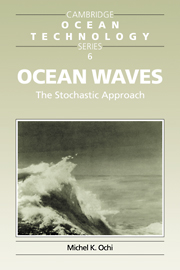Book contents
- Frontmatter
- Contents
- Preface
- 1 Description of random seas
- 2 Spectral analysis
- 3 Wave amplitude and height
- 4 Wave height and associated period
- 5 Sea severity
- 6 Estimation of extreme wave height and sea state
- 7 Directional characteristics of random seas
- 8 Special wave events
- 9 Non-Gaussian waves (waves in finite water depth)
- Appendix A Fundamentals of probability theory
- Appendix B Fundamentals of stochastic process theory
- Appendix C Fourier transform and Hilbert transform
- References
- Index
9 - Non-Gaussian waves (waves in finite water depth)
Published online by Cambridge University Press: 15 October 2009
- Frontmatter
- Contents
- Preface
- 1 Description of random seas
- 2 Spectral analysis
- 3 Wave amplitude and height
- 4 Wave height and associated period
- 5 Sea severity
- 6 Estimation of extreme wave height and sea state
- 7 Directional characteristics of random seas
- 8 Special wave events
- 9 Non-Gaussian waves (waves in finite water depth)
- Appendix A Fundamentals of probability theory
- Appendix B Fundamentals of stochastic process theory
- Appendix C Fourier transform and Hilbert transform
- References
- Index
Summary
INTRODUCTION
The statistical analysis of ocean waves discussed in previous chapters assumes that waves are a Gaussian random process; namely, waves are a steady-state, ergodic random process and displacement from the mean obeys the normal probability law. Verification that deep ocean waves are a Gaussian process was given in Section 1.1 through the central limit theorem. It has also been verified through observations at sea as well as in laboratory tests that waves can be considered a Gaussian random process even in very severe seas if the water depth is sufficiently deep.
The above statement, however, is no longer true for waves in finite water depth. Time histories of waves in shallow water show a definite excess of high crests and shallow troughs as demonstrated in the example shown in Figure 1.1(b), and thereby the histogram of wave displacement is not symmetric with respect to its mean value, as shown in Figure 1.2(b). Thus, waves in shallow water are considered to be a non-Gaussian random process. This implies that ocean waves transform from Gaussian to non-Gaussian as they propagate from deep to shallow water.
Figure 9.1 shows a portion of wave records measured simultaneously at various water depths during the ARSLOE Project carried out by the Coastal Engineering Research Center at Duck, North Carolina.
- Type
- Chapter
- Information
- Ocean WavesThe Stochastic Approach, pp. 255 - 282Publisher: Cambridge University PressPrint publication year: 1998



